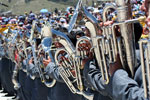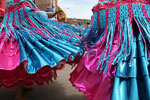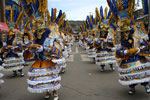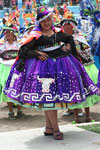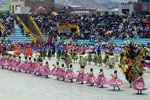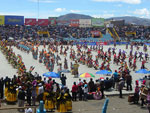Fiesta de la Virgen de la Candelaria
Virgin of Candelaria Feast
Faith in the folk capital of the Americas
Color - dance - music - dresses - masks and lovely people
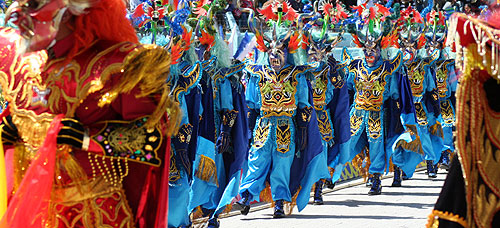
The Feast in honor of Virgin of Candelaria, patron of the city of Puno, is made in the first fortnight of February each year, and represents the largest and most important cultural event, musical and dancing by Peru, and one of the three most significant in South America along with Carnival in Rio de Janeiro and the Carnaval de Oruro, in the amount of symbols and artistic and cultural manifestations of the cultures themselves Quechua, Aymara and mixed by Highlands Andean and the volume of people directly and indirectly involved in its realization.
The core of the festival is the musical and dance expression and organized by the Regional Federation of Folklore and Culture of Puno, calling the presence of more than 150 sets, between native dances that come from the communities and biases of Puno, and sets of dances organized in different districts of the City of Puno, mostly known as 'dances with costumes", which directly involved 50 thousand dancers and some 15 thousand musicians, adding to its indirect stake about 25 thousand people including directors, sponsorships, embroiderers, artisans in the making of masks, boots and shoes, bells and other items. For the first nine days, the mayordomos (those in charge of organizing the festivities), decorate the church and pay for Mass, banquets and fireworks displays.
This party is uninterruptedly celebrated since 1960. It convokes many communities and dance groups of the whole south area of Peru and foreign delegations who are presented in big artistic competitions arriving with their own musical groups and dramatize in beautiful choreographs in parades by the streets and contest dance in the Torres Belón stadium of Puno.
Celebration and activities
This festival is presented the following times: trials, novenas, albs festive candles entry, entry k'apos, eve, February 2, eighth, veneration, cacharpari.
The feast of the "Virgen de la Candelaria" begins on the eve of the 2nd of February and last until the first Sunday after that day, and ends one week after continuing with the celebration of the Carnivals. On February 9th the folklore parade is celebrated. The groups, which paraded days before, on the 2nd, now return for a procession before the Virgin, who will gaze them from the atrium of the church. Then, folk groups set off through the city, dancing tirelessly until sunset. At the end of the week the feast ends in the cemetery, for the paying of respects of the dead.
The statue of the Virgin is small, and it represents a virgin of very white complexion and blushed cheeks. This Virgin is harbored in the Church of San Juan El Bautista.
Its origin is related with the beginnings of the cult to the "Virgen de la Candelaria" (Candelaria Virgin) or "Virgen de Socavón" (Virgin of the Tunnel) in Bolivia. Is much venerated in Puno and Oruro, Bolivia.
In the afternoon's central day, the virgin statue leaves the church, and more than forty groups attired in the costumes and masks classic in the culture of altiplano dance, join crowd. Without doubt the outstanding groups are the Diablada, the Morenada, the Waka Waka, the Llamerada, the Tuntuna, the Caporal King, the Kallahuallas, and the Sikuri groups.
On the main day, February 2, the virgin is led through the city in a colorful procession comprising priests, altar boys, the faithful, Christians and pagans carefully maintaining the hierarchy. This is the moment when the troupes of musicians and dancers take the scene, performing and dancing throughout the city.
The festival is linked to the pre-Hispanic agricultural cycles of sowing and harvesting, as well as mining activities in the region. It is the result of a blend of respectful Aymara gaiety and ancestral Quechua seriousness.
The dancers, blowing zampoña panpipes and clad in spectacular costumes and outlandish masks, make their offerings to the earth goddess Pachamama. The most impressive masks, for their terrifying aspect, are those of the deer fitted with long twisted horns similar to the Devil, and Jacancho, the god of minerals.
During the farewell, or cacharpari, the dancers who fill the streets finally head to the cemetery to render homage to the dead.
La Diablada
The Dance of the Devils, or "diablada", the main dance of the festival, was allegedly dreamed up by a group of miners trapped down a mine who, in their desperation, resigned their souls to the Virgen de la Candelaria.
The "diablada" dance is born with the legend of some miners trapped in a collapse of a mine; they saw an army of demons that took them to hell illuminated with fire flames. The miners commended to the Virgin who kept them with life producing their rescue.
From that time all the miners called her their landlady and protector, and she was called the Virgin of the Candela or Candelaria.
The "diablada" is the dramatization of this legend, the fight among the good and bad, which is presided by an archangel that dominates the demons that are accompanied by the "chinasupay" (the devil's woman), in the processions of the feast. The fantasy clothes worn during this dramatization are a masterpiece.
Candelaria Feast 2012
January 30th |
XLVII Native Dance Contest |
February 1st |
06:00 am Dawn mass - Enter the kappo dancer and ceremony to Pachamama |
February 2nd |
09:00 am Mass in the Cathedral |
February 3 to 6 |
Festival "segunda novena" Music and dancer with light dresses |
February 5th |
Election and coronation of Queen of Folklore |
February 6th |
XLVII Dance Contest - Torres Bellon Stadium |
February 7th |
Ceremony Veneration to Candelaria Virgin and dancers in front to church and parade in the streets of Puno |
February 8ht |
IX Concert of Folk Music Bands - Main Square |
February 9 and 10 |
Parade on the streets of dancer and music groups |
Tour Candelaria Feast 2013
Virgin of Candelaria Feast Photo Gallery:
- Virgin of Candelaria Feast - Blue
- Virgin of Candelaria Feast - Green
- Virgin of Candelaria Feast - Red
- Virgin of Candelaria Feast - Yellow
- San Juan Bautista Church
 LAKE TITICACA AND PUNO - PHOTO GALLERY
LAKE TITICACA AND PUNO - PHOTO GALLERY
- Puno City
- Andean Explorer Train
from Cuzco to Lake Titicaca - Lake Titicaca
- Sillustani Archaeological Site
- Pucara - Museum and Church
- San Juan Bautista Church
- Amantani Island
- Taquile Island
- Uros Islands
- Yavari Project
- People of Taquile Island
- Uros Islands - People
- Uros Islands - Reed boats and Houses
- Dances of Puno
- San Santiago Feast in Puno
- San Santiago Feast in Taquile Island
- Virgin of Candelaria Feast - Yellow
- Virgin of Candelaria Feast - Green
- Virgin of Candelaria Feast - Blue
- Virgin of Candelaria Feast - Red



